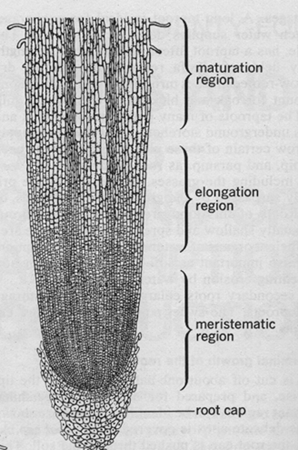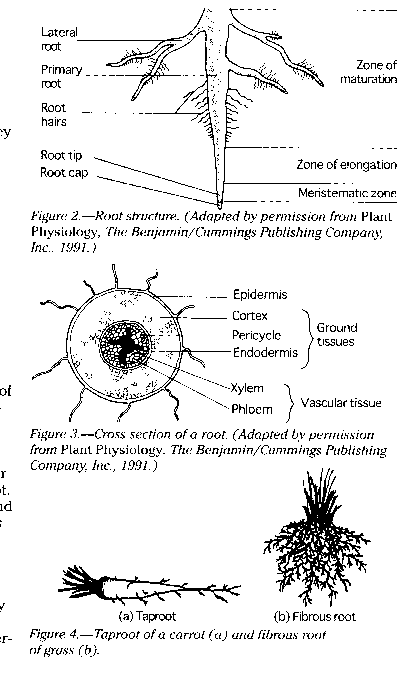Lesson Overview
This lesson is designed to take an in-depth look at the root systems of plants. Growth processes and functions of roots will be investigated.
Goals for this lesson
- understand the principal parts of root systems
- understand the functions of roots in plants
- learn the growth processes associated
with roots
Tasks
- visit the produce department of a grocery store and examine various roots used for food sources
Vocabulary (note: while it is not necessary to submit written definitions of these words for this lesson, you are responsible for knowing what they mean.)
meristematic zone, zone of elongation, zone of maturation, epidermis, cortex, vascular tissue, xylem, phloem, root cap, root hairs, symbiotic relationship, mycorrhizae, fibrous roots, tap roots, primary growth, apical meristem
Assessment
- completion of activity below
Reading
Roots are an often overlooked part of plants primarily because they are hidden beneath the soil ('out of sight, out of mind'). A plant's roots however, have a profound effect on a plant's size, habitat type, method of propagation, and nutritional needs.
Roots typically originate from the lower part of a plant. They have distinct structures but lack nodes and never create leaves or flowers directly. Their major functions are to absorb nutrients and water from the soil, anchor the plant to the ground, provide support for the rest of the plant, and store food. In some plants they can be used for propagation.
Roots can vary in size from the unbelievable 14 million root segments totaling 380 miles in length in an adult rye plant (a grass-like plant with a fibrous root system) to the unexpectedly shallow root system for some large trees. Trees as tall as180 ft. in tropical regions can have a root system that averages little more than 3 ft. into the soil.
Root Structure
Internal:
Internally there are three major root parts (see figure below):
- The meristematic zone is at the tip of the root. The meristem is responsible for making new cells; it is the area of cell division and growth.
- The zone of elongation is behind the meristem. In this area, cells increase in size through the absorption of food and water. As these cells grow they push the root through the soil.
- Directly below the stem is the zone of maturation. Here, cells become specific tissues such as epidermis, cortex, or vascular tissue.

Diagram showing the 3 major internal root parts.
Root Tissues
- Epidermis cells are the outermost layer of cells in a root. Similar in location and appearance to your skin cells. They are responsible for absorbing water and the minerals that are dissolved in the water they come in contact with.
- Cortex cells are involved in moving water from the epidermis to the vascular tissue (xylem and phloem) and in storing food.
- Vascular tissue is located in the center of the root and conducts food and water to and from other parts of the plant. These tissues are composed of both phloem and xylem cells. Xylem is a specialized tissue for transporting water from the roots up to all other parts of the plant. Phloem is another specialized plant tissue, its function is to transport food molecules from the leaves where they are produced by photosynthesis to all other parts of the plant including the roots. Think of these tissues as equivalent to an animal's circulatory system.

External
External root structures of importance include the root cap and the root hairs. The root cap is the root's outermost tip. It consists of cells that are sloughed off as the root grows through the soil. Its function is to protect the root meristem. Root hairs are delicate epidermal cells that are present in the area just behind the root's growing tip. They are very tiny fibrous structures and have the important function of increasing the root's surface area several hundred-fold for absorbing water and nutrients.
Many roots have a naturally occurring symbiotic (mutually beneficial) relationship with certain fungi. This relationship further improves the plant's ability to absorb water and nutrients. These beneficial relationships are called mycorrhizae (meaning fungus + root).
Root Systems
There are two types of root systems found in plants. Plants use one or a combination of both to anchor themselves to the ground.
- Fibrous root systems consist of many thin, branched, roots. Fibrous roots occupy a large volume of soil around the plant's base and since they grow relatively close to the soil surface they are effective at controlling soil erosion. Grasses are good examples of plants with this type of root system.
- A tap root system consists of one or two, rapidly-growing roots with few branches that extend straight down into the soil. These roots draw water and nutrients from supplies deep in the soil. Tap roots are especially good anchors for plants growing in shifting soils or windy locations. Carrots and pecan trees are examples of plants with tap root systems.
Food Storage
Food is stored in both root types with tap roots having a much greater storage capacity. Carrots and sweet potatoes, are excellent examples of tap roots adapted for food storage. Some of our important food sources are tap roots. When the tops of perennial plants die off in the winter or when the leaves fall and stems become dormant it is the tap root system that allows the quick regrowth of new leaves in the spring.
Root Growth
Since the main purpose of roots is to move throught the soil in search of water and minerals at a distance from the plant, primary growth (increase in length) is their most important growth process. It is the apical meristems that are the key to the root's success. Apical meristems are just behind the root cap and produce new cells through the process of cell division or mitosis. The new cells are formed in layers as the growing root pushes through the soil. This production of new cells occurs at the tips of each root segment in fibrous roots and on the main root and lateral roots of plants with tap roots. Each root segment has an associated band of root hairs just back from the root tip.
Factors important in root growth
The following factors are important in root growth:
- Roots in water-saturated soil grow poorly and may die due to lack of oxygen.
- Roots will penetrate much deeper in soil that is loose and well-drained than in compacted poorly-drained soil.
- Plants often grow laterally beyond their dripline (an imaginary line on the ground directly beneath the outermost tips of a plant's foliage) so be careful when digging in soil near other plants.